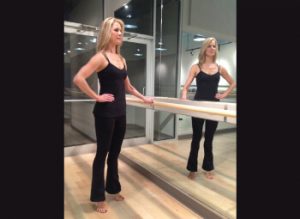Today we welcome Jennifer McCamish, owner of Dancers Shape barre fitness studio in Austin, Texas as a guest blogger on Mind Your Body TV. She recommends that all older adults incorporate strength training, targeted stretching, and perhaps most importantly, lateral stability exercises into their weekly routine. She should know: She’s a former Radio City Music Hall Rockette! I think her list of older adult exercises is spot on, and hope you’ll give them a try today.
“Maintaining mobility and independence as long as possible is one of the main goals for an active older adult,” McCamish says. “Clinical studies report that an exercise program can slow the progress of age-related conditions like osteoperosis, sacropenia and may even contribute to delayed onset of mental health issues like Alzheimer’s. Implementing Pilates and barre-type exercises can help improve posture, alignment and stabilization for a strong and mobile body with good balance—imperative for preventing falls.”
McCamish sent us so many exercises, that I’ll run Part I today and Part II Friday. Why not print these off and tape to your mirror—a reminder to do them, and to do them correctly.

Top 10 Exercise Tips for Active Older Adults
1) Breathing
- Start by standing with feet hip distance apart, knees softly bent and shoulders stacked over hips. Press your shoulders away from ears to lengthen your neck. Think like you are growing a tail from head to tail. Begin to inhale through your nose and let the sides of the lower ribs expand with air without letting your ribcage splay apart or shoulders rise up. Begin to exhale through pursed lips and feel the triangle area between the hip points and pubic bone pull back towards your spine, like you are trying to zip up tight pants. Hold 2, 3, 4 and then inhale again through the nose repeating the exercise several times. You should feel the abdominal wall squeeze tight around the midsection, between the ribs and hip bones, like a corset lacing up tightly.
2) Warm up thoroughly
- Warming up is important because it circulates the blood and oxygen, preparing the muscles, joints and brain for an effective workout. Begin marching in place and then graduate to lifting the knees to a comfortable height for several minutes. Then incorporate side-stepping: step R tap L, step L tap R or step together, step touch sideways. Side-stepping will warm up the adductors and abductors and offer a balance challenge.
3) Pitched fly
- It is important to strengthen the upper back to improve posture, which directly relates to balance. Use an appropriate set of hand weights, approximately 3 – 6 lbs. Soften knees and engage the transverse abdominal wall. Keep your corset tight for lower back support, as you pitch forward at the hip joint, keeping the spine long and not rounding forward. Softly bend elbows like you are hugging a tree. Begin to exhale as you open your arms out to the sides of your shoulders. Feel the sensation of trying to crack a nut in between the shoulder blades without letting the shoulders creep up to the ears. Inhale to return.
4) Internal and External Rotation
- Tie a TheraBand on to a door handle that is close to your hip height. Stand a few feet away from the door, with the side of your hip facing a doorknob, and grab one end of the band with your inside hand. Place elbow at the waistline with your forearm facing frontwards. Exhale as you close your forearm over your waistline and inhale to open back out. This is internal rotation. Change the band to the opposite hand and repeat the exercise facing the same way for external rotation. Make sure to control the band as you open and close, not letting the band pop back. Also move from the shoulder socket without twisting your pelvis or shoulder to help open and close the band. You may stand closer to the door or further away for more of a challenge.
5) Side Leg Lift
- Falls are one of the biggest concerns for older adults, so improving your balance is critical. The abductor and adductor muscles that surround the hip can become underutilized because we don’t use them as much in our daily activities but they play a critical role in balance. Soften your knees and lean into a sturdy surface like a countertop with your forearm. Press your shoulder down away from your ear while not letting your ribcage collapse towards the floor. Exhale as you lift your outside leg away from the body. Flex your foot and feel energy out of your heel as you rotate your heel to the ceiling without letting your pelvis roll forward. Keep your hip bones stacked on top of one another. Inhale to return.
Come back Friday for more from McCamish.